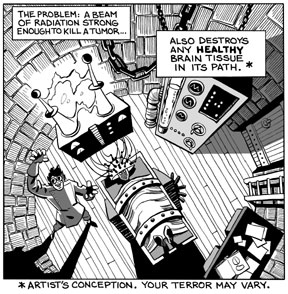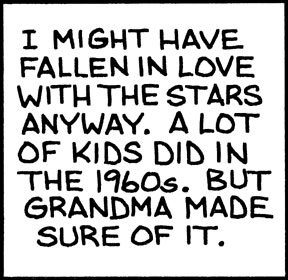That’s a fair enough objection, I think. At the risk of getting too textbooky, I’ll explain myself and then add a few thoughts about exactly how obligated to truth I believe an artist can or should be. It’s not my job to tell anyone what art to like or not like (hi, Nurse Sis!). But I can defend my rationale.
First, a little rainbow physics. Your standard rainbow appears when sunlight behind you hits raindrops in front of you. Each individual spherical raindrop becomes a prism that refracts white sunlight into its component colors and reflects it back to your eye. It’s important to remember that a rainbow isn’t a “real thing out there,” but an optical phenomenon that the observer is a part of. Everybody sees a slightly different one.
(This suggests an interesting analog to the old koan, “If a tree falls in a forest and there’s no one there to hear it, does it make a sound?” I never understood why that was considered a profound puzzle: the answer is obviously Yes. However, if sunlight hits a raindrop and there’s no one there to see it, does it make a rainbow? Maybe not.)
A rainbow’s arc is always a portion of a circle, and the angle sunlight makes going in and out of each raindrop is always the same: 42 degrees. This has some interesting corollaries: the angle described by the center of the rainbow’s arc, the observer, and the rainbow is likewise always 42 degrees.
Furthermore, all rainbows are the same size—you just see more or less of them depending on how high the sun is in the sky. When the sun’s low, you see more of the circle; when it’s high, you see less. That’s what impressed me about the rainbow my wife photographed: with the sun about as low as it could be, the rainbow was about as big as it could get.
The Crime of Kinkade
I tried to find the objectionable Thomas Kinkade painting online but couldn’t. I only saw it once a few years ago, but as I best recall (and I apologize if I recall incorrectly) the critical elements looked like this:

You can make rainbows many different ways, but the one indispensable element is light. A bright light source has to be either directly behind the observer opposite the rainbow, or at the exact center of the rainbow behind it (for example, you can sometimes see a night rainbow circling the Moon formed by ice crystals in the sky).
Where’s the light source in this painting? The sun isn’t directly behind the observer nor directly behind the rainbow. It’s off to one side. There’s no enormous spotlight shining onto or out of the waterfall. The only way this rainbow works is if it’s on a planet with two suns, like Luke Skywalker’s home of Tatooine, and one of those suns is shining behind us. But even then, the rainbow is so far up the mountain that the second sun behind us would have to be impossibly below the horizon. If Kinkade added a Jawa or Sand Creature to this painting I’d be more satisfied, because this rainbow couldn't happen on Earth.
There’s a more subtle problem with the rainbow as well. As mentioned, the angle between a rainbow’s center, an observer, and the rainbow’s arc is always 42 degrees. That means that an entire rainbow, side to side, takes up 84 degrees of the observer’s world view. Think of it like this: if you slowly turned in a 360-degree circle and saw rainbow after rainbow lined up side by side along the horizon like McDonald's Golden Arches, there’d be just over four of them before you circled back to where you started.
The problem with Kinkade’s rainbow, then, is not just that it’s in the wrong place but that it's far too small. You could have fit several rainbows side by side in the painting I remember without going all the way around. Kinkade was clearly thinking of a rainbow as a physical “real thing out there” that should follow the rules of perspective and look smaller when it’s farther away. But that’s not how rainbows work.
Is There in Truth No Beauty?
So what?
A lot of artists draw and paint a lot of things that aren’t necessarily technically accurate. Have I never heard of artistic license? Never made a mistake myself? Am I trying to suck the fun out of everything?
That kind of depends on what you think art is about. I’m not a soulless drudge. I’d never criticize a child for drawing the sun beside a rainbow or getting the colors mixed up. And abstract artists can do whatever they want. Still....
When I was in college, a friend who wanted to sell his racing bicycle asked me to do a drawing of it that he could post with a flyer (this was in the Dark Ages, kids, when we couldn’t just upload a digital photo and print it in full color. Although we did have photocopiers, which saved me the trouble of chiseling the bike’s image in marble).
So with my friend’s bike as a model I drew it as best I could. When I proudly unveiled my creation to him, he scoffed, “That looks like my grandmother’s Schwinn!” Then he took me by the hand and patiently explained to me all the features that made a racing bike different from grandma’s Schwinn. I was struck by how wrong I’d gotten it. The proportions, the angles of the posts, the wheels... Even though it was sitting right in front of me, I hadn’t drawn his bike at all. I had drawn a completely different bike that existed in my head.
I think a fundamental responsibility of artists is to view the world as accurately and convey it as honestly as they can. To really see what they’re looking at and then communicate it. That's very hard to do! A big part of that responsibility is knowing what you don’t know and being willing to find out. I didn’t know anything about racing bikes but didn’t know I didn’t know. I learned.
If I set out to draw a horse, I’d surround myself with horse references. If I tried to draw a World War II tank, I’d google up as many tank pictures as I could find. I’d probably still botch the job: there are things about horses only a horse person knows and I’m sure there’s a tank guy out there who’d get mad because I put a 1944 model in a story set in 1943. And doctors and nurses laugh at medical shows (you ought to hear Nurse Sis gripe about “E.R.”), cops laugh at cop shows, lawyers laugh at law shows, and cartoonists laugh at cartooning shows (“Caroline in the City” anyone?). You could get paranoid and paralyzed pretty quickly, afraid to move a muscle. Nobody knows everything! What’re you supposed to do?
Cartoonist Mort Walker wrote about how when he started “Beetle Bailey” he took great pains to be sure the rifles, tanks, and other equipment were drawn accurately. He soon realized that didn’t work. In his comic strip world, his generalized abstractions of rifles and tanks worked better than truer representations. The symbols were more effective than the objects they symbolized. That’s probably true for a lot of cartooning and non-representational art but a problem for an artist like Kinkade, who is clearly portraying places that, though idealized, are meant to look like they could exist.
Another story: One of my favorite panels in Mom’s Cancer is the one of my mother strapped down in Frankenstein’s lab.

The metaphor conveys her perspective of the terrifying experience, but my original intent was to draw a realistic picture of her lying on the actual machine used to treat her. I scoured the Internet looking for a picture of the machine, all through the hospital’s and manufacturer’s websites, and couldn’t find one. That wasn’t a detail I wanted to risk getting wrong so I evaded it as creatively as I could. It worked great, better than my original idea, but it was essentially a cheat to cover my ignorance of stereotactic radiosurgery (sorry, I must have missed that day of class). There are a lot of ways to solve the problem.
I make mistakes and take shortcuts (I'm painfully aware of mine, no need to point them out), everyone does. All I’m looking for is a good-faith effort. An artist who makes his living as a “painter of horses” should know horses. A “painter of tanks” should know tanks. And a “painter of light”....





 I think the bottom example is easier on the eye. Notice that kerning doesn't mean squishing all the letters together (that's "tracking"), but overlapping the space only between certain letters. If it's absent, words can subconsciously look funny even if you can't figure out why; if you do it right, no one ever notices.
I think the bottom example is easier on the eye. Notice that kerning doesn't mean squishing all the letters together (that's "tracking"), but overlapping the space only between certain letters. If it's absent, words can subconsciously look funny even if you can't figure out why; if you do it right, no one ever notices.





